
|
|
|
Check these out    Do you have an entertaining or useful blog or personal website? If you'd like to see it listed here, send the URL to leon@pawneerock.org. AnnouncementsGive us your Pawnee Rock news, and we'll spread the word. |
Too Long in the WindWarning: The following contains opinions and ideas. Some memories may be accurate. -- Leon Unruh. Send comments to Leon September 2008The days grow short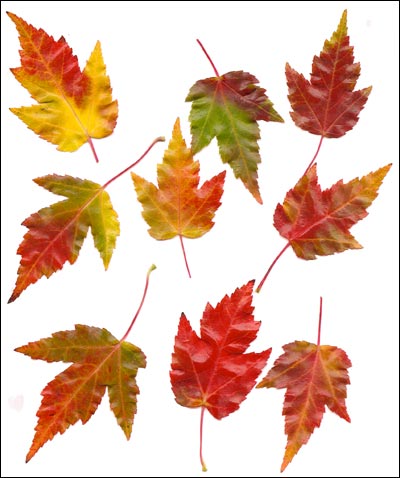
Oh, it's a long, long while from May to December [September 30] The last of September ends the reasonable hope of warm days and short-sleeve evenings. Frost will be on the pumpkin soon. But as long as we remember hollyhocks, we will always have summer.
Nurses who are men: Ray Randolph, our friend in Indiana, was interested in the piece about Donovan Unruh, a former Pawnee Rocker who was recognized in the Hutchinson News for his nursing career. "Pioneers . . . or maybe just minorities. In 1967 when I made the transition from a Lutheran preministerial curriculum to nursing, I was the fourth male to enter Indiana University School of Nursing, and, I think, the third to make it through. There was just "Ray" and about 100 women in my class. How many more men at IUSON since I graduated in 1970, I have no idea because I haven't kept track." Donovan Unruh, nurse[September 29] Donovan Unruh, who would have been a member of the Pawnee Rock High School class of 1956 (or thereabouts), is written up in the Hutch News for his nursing career. Reporter Kathy Hanks' story and photo appear under the headline: "His dream job: Man hasn't let age, or gender, stand in the way of achieving the lifelong goal of being a nurse." Here are a couple of paragraphs: "Unruh, a 70-year-old registered nurse on the Skilled Nursing Unit at Promise Regional Medical Center, has a gentle touch." "Back when he was growing up in Pawnee Rock, he was fascinated with the medical field. He was drawn to nursing, inspired by his mother who worked for 20 years at Larned State Hospital as a nurse aide. But when he went to enroll in Bethel College in 1957, nursing wasn't an option." Read the full story.
But in Saturday's Nationwide race -- NASCAR's second-tier circuit -- Bowyer finished second. He leads the Nationwide series for the season. You could be president[September 28] In third or fourth grade right there in Pawnee Rock, each of us was told that in this great land of America, you or I could become president. I imagined that one day the call would go out and ring at my house. "We've heard you're a really good student," a well-modulated voice would say. Or, "We heard you wrote a couple of newspaper stories that were insightful. You must understand our government. Can you run for president?" Some people hear the voice without the phone ringing first. Al Carris of Pawnee Rock was one of those fellows. As I went through the years, I began to understand that the Fairy of Good Politics wasn't going to sneak up one morning and tap me on the shoulder. If I wanted to be president, I'd have to (1) be political and (2) understand a lot of finance, government, education, foreign policy, and history. That's a lifetime of preparation to lead the best and brightest country in the world. Now it's clear that I overestimated the work required in order to run for vice president and later president.
In Alaska, we were as stunned as anybody, maybe even Mitt Romney, when McCain chose Palin. There's a sense of enchantment in the political air, because a lot of people here seem to feel that we'll have either a forward-looking president or an Alaska-raised vice president. We can't lose. (You remember the excitement we Kansans felt when Bob Dole ran for vice president in 1976.) Governor Palin can read a good speech -- and I earlier appreciated a Memorial Day speech she produced herself -- but she is not the queen of foreign policy or of higher education or of making sure children get good health care. On the state level, she is considered a reasonably good leader and was smart enough to know the right time to drive a pitchfork into our amazingly corrupt state government. The proper level of national expectation could have been made clear on the very first day if McCain's campaign hadn't overblown everything by saying she has foreign policy experience because she lives next to Russia. What is true is that she has a different perspective on the world because she governs a state that crosses the Arctic Circle and because she lives only 800 miles from Russia. That's what Alaskans have, living around the corner of the world from Washington and Pawnee Rock and Arizona. Sarah Palin does make a good speech, and maybe that's enough. When I was a child, that's how I dreamed it was to be president. Yesterday afternoon I took our sons to collect campaign buttons from the local Obama and McCain headquarters. Although I can't be involved in either campaign, I am more than glad to help the boys learn about the political process.
This campaign is the first time my wife has been interested in politics -- interested in the sense of thinking things can get better and she can help -- and the boys decided to pick up a little something for her birthday. Then we drove a few blocks to the McCain office, where I talked a volunteer into letting us in after closing hours and we bought three buttons. One of the higher-ups invited us to the grand opening of the office today after church. The lieutenant government -- the next governor? -- would be there. All the people were enthusiastic, although I was reminded of being in a real estate office.
Depending on which side of the fence you're on, the button is either a statement of belief in the continuity and rebirth of the Republican Party or a warning label. Game time[September 27] When you and I were growing up, back in the misty dawn of time, we didn't get much gambling action in Pawnee Rock. Sure, there were penny-ante poker games played by high school seniors and pitch games played in the basement of Farmers Grain by our fathers and the odd canasta match played by our urbane cousins when they came to town. My dad, saying it was a skill he had learned in high school, taught me how to pitch pennies against the wall of his carpentry shop downtown.
Gambling in those days wasn't the way of life it is now, what with poker played incessantly on TV and the lottery getting a little results box in the newspaper and lots of advertising on convenience-store windows. The tight-collared people of Kansas appear to have loosened up. Still, it's a little odd to see the good folks of Dodge City -- only a short hour away on U.S. Cattle Truck Highway 56 -- welcoming the regional casino, as we find in this story in the Hutchinson News. Yes, I know that games of chance and hookers are a proud part of the city's Wild West tradition, but I must have lost touch with Dodge during the days when it was happily a part of the rural Kansas anti-everything movement. On my next trip to Kansas, I hope I'll make it to Dodge. I want to meet Don Ross, and I want to play 21 . . . may lightning not strike me dead. Reading on the road[September 26] Laramie Unruh of Valley Center adds to our library of favorite and useful books about Kansas.
I concur with Laramie's judgment. I've spent many hours preparing for trips and reliving bike rides by following the authors' descriptions of the landscape the highways cut through and roll over. The book is a classic. And in case you're not familiar with Buchanan's book, I'd also recommend "Kansas Geology: An Introduction to Landscapes, Rocks, Minerals, and Fossils." Also, here's a piece my sister wrote after attending a Flint Hills field trip with Buchanan. Bobby Foster dies[September 26] Robert "Bobby" Foster, son of Doyle and Maxine, has died at his home in Larned. He was 61 and was a corrections officer at Larned State Hospital and a farmer. His family has Pawnee Rock roots, and his father is buried in Pawnee Rock Cemetery. (Obituary) Five books we like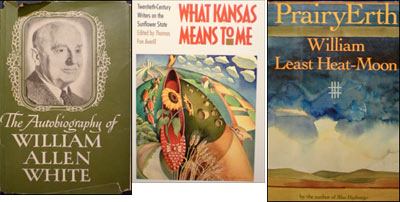
[September 25] Yesterday I asked you which books you'd recommend to distant cousins who asked you for advice about Kansas. Barb Schmidt of Seattle and Cheryl Unruh of Emporia had some ideas: Barb's choice: The book that made me most proud to call myself a Kansan was "The Autobiography of William Allen White," which I first read decades ago as a journalism student at KU. It is full of truth, not only about Kansas and Kansans but also about human nature (the best and worst of it) and a crucial segment of American history. I know I do not need to mention this book to you (or your sister), but it simply must be on the list. And it is still one of the best biographies I have ever read. Cheryl's choices: Cheryl likes these three: • "What Kansas Means to Me" -- edited by Thomas Fox Averill My two cents: I have all four of those books (three copies of White's autobiography, in fact), and I think they're excellent choices. In addition, I'd like to suggest one of my favorites: William Least Heat-Moon's examination of Chase County, "PrairyErth." Thanks for your recommendations, Barb and Cheryl. What does everyone else suggest? The best Kansas books[September 24] As the former editor of Alaska.com, once an all-about-Alaska site and now a travel site, I have accumulated a bit of knowledge about my adopted state. I still get e-mails from the site's users who want to know a little more about the state, and I'm glad to share. Most of the e-mails in the past month have been about the population of the state -- a question I'm sure is related to the choice of Sarah Palin as the Republican vice presidential nominee. Normally, that kind of question is asked by fifth-graders approaching the deadline for their report about the Last Frontier. (The answer, by the way, is about 683,000 [in 2007]. Alaska has a larger population than Wyoming, Vermont, and North Dakota.) But one e-mail I got this past week was different. A family from the East Coast plans to move to Alaska and wanted to know which books to read in order to be prepared for their new life in a strange place. Their e-mail made me wonder: What list of books would Kansans -- citizens of a state with at least as many cliches and false legends as Alaska -- compile for people moving in from long away? Which books tell the truth? Which catch the flavor of the Sunflower State? Pretend your distant cousins are moving to Kansas. Tell us the one or two books you'd recommend. The day a baby was born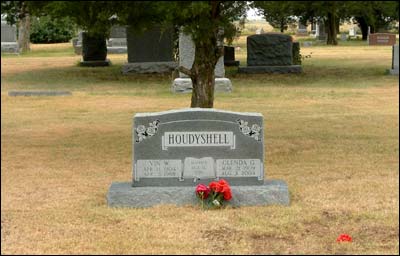
Glenda (1909-2004) and Vin Houdyshell (1904-1988) are buried in the eastern section of the Pawnee Rock Cemetery. [September 23] Dana Hines, who sent an obituary that was reprinted here, looks gently at life. She wrote: My dad was born in 1926, too. So many times I think about what the day must have been like on the day a loved one was born, all those years ago. Was the town abuzz with the news? Did people come to call and see the new baby? The fresh-skinned little hands of the newborn who grew up into an older (God willing) man or woman always come to mind for me. I remember looking at my dad's hands when he was an older man -- all the years of hard work imprinted on them. When my grandmother, Glenda Houdyshell, died in 2004, I wrote my recollections of her, titled "My Grandmother's Hands," and then read it at her funeral there in pretty Pawnee Rock Cemetery. Mr. Doyle Foster, bless his soul, was there that day. He had been our principal in junior high. He looked as marvelous as ever and was such a sweet man. I grieved when he died. Anyway, Mrs. H must have been quite an example of goodness and family. Closer to history than I thought[September 22] Yesterday I wrote with wistfulness about the family of Alice "Mrs. H." Daniels. It turns out that I was closer to history than I thought. When my mom, Anita, was a kid, she and her family lived in Radium and then Larned. She sent this note yesterday:
Yes, I did know Pete. He was a salty old dog who kept the Tiller and Toiler's press running, sometimes with a wrench and sometimes with a wrenching word. He was a nice guy and almost always pleasant to me. I liked Pete. I helped him push big rolls of newsprint around, and he introduced me to the blankets, rollers, and inkwells of the offset press. I wish I had known about the Pawnee Rock part of his family's history. Mom probably told me about it at the time, but you know how shortsighted kids can be. "Mrs. H. Daniels suddenly passed away"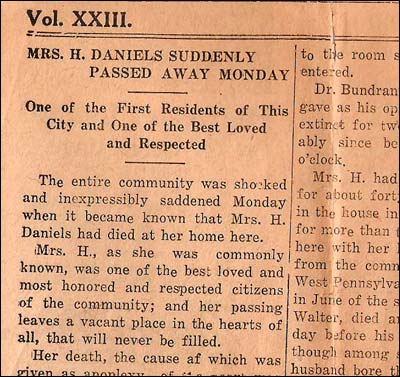
This is the beginning of Mrs. Daniels' obituary in the Pawnee Rock Herald of December 16, 1926. See the full obituary. [September 21] After her trip to Kansas in midsummer, our friend Dana Hines of Tucson sent a copy of Alice Belle Chestnut Daniel's obituary. Perhaps you've heard of Mrs. John H. Daniels or, as the obit says she was known, Mrs. H. "Ginny Houdyshell had given me a bagful of very old newspaper clippings found at my great-grandmother Lucy Houdyshell's house when they cleaned it out," Dana wrote. "I have opened the bag today and have sat here mesmerized by some of the articles. "This one struck me in many ways -- its eloquence and vivid descriptions are quite profound! I thought you might find it intriguing, too." Dana's interest in the article arises, first of all, because of her great-grandmother's interest in Mrs. Daniels. But also, and for the rest of us as well, the obituary from the Pawnee Rock Herald is beautifully written in a disused style. Finally, it helps us understand the hardships endured by one of our town's early families and, by extension, our ancestors. I don't think this kind of newspaper writing is possible now. Newspapers, including those surviving in smaller towns, have become distant from their readers. Some families themselves might object to having their stories -- even heroic tales like this one -- opened to public consideration. But even as we lament the loss of this communication, I am inspired to examine and imagine the lives of others of her time -- my relatives as well. Were we to write their biographies, what illuminating anecdotes might we tell?
To provide an idea of how long ago Mrs. Daniels was born (September 1862), bore children, ran her boarding house, and was called to the Church Triumphant, I note that she died in 1926, the year my dad was born. Imagine -- a baby has grown into an 82-year-old grandfather since Mrs. Daniels' obituary appeared. The Depression and wars have come and gone, presidents ruled and died, and Pawnee Rock grew and shrank. Lucy Houdyshell kept this clipping because Mrs. Daniels was important to her, and Ginny Houdyshell and Dana Hines have both passed it along until it reached us. Were it not for obituaries such as this, Mrs. Daniels might well have been lost to the ages. Hers is a story worth keeping, but couldn't we say the same for many of our ancestors? Please keep their stories alive -- their stories are our history. 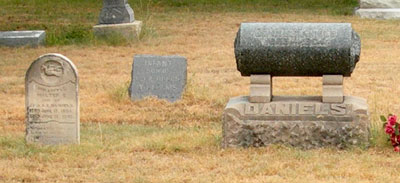
The graves of John H. Daniels and young son Walter, just north of the grave of Alice "Mrs. H." Daniels." Looking back at Mr. Howerton[September 21] Laramie Unruh of Valley Center wrote: "Mr. Howerton drove me to school almost every day for seven years. I thought it was sad his obituary said nothing of his many years of service to the school. The morning of his funeral I couldn't quit thinking of all the days of me watching the mirror above his head, hoping he wasn't looking at me." Survival lessons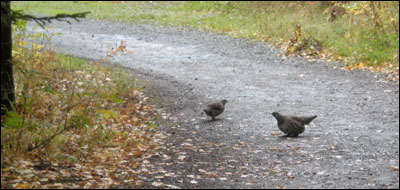
Spruce grouse on the trail. [September 20] Being a dad, I'm constantly on the lookout for teaching moments, and my sons are remarkably good at appearing attentive. Once in a while, they really do listen. Yesterday held one of those moments. We went out to the state park near where we live now with the intention of seeing spawned-out salmon and maybe a bear. As we walked down to the creek, I stopped the boys with a hand signal. On the trail before us were spruce grouse. Spruce grouse are possibly the dumbest animals this side of a cow. I have walked up quietly and tapped them on the back as they pretended I didn't see them. Seeing the grouse brought to mind a book they read a couple of years ago, "Hatchet." It's about a kid who is in a small plane that crashes in the Canadian woods and how he survives for days with a hatchet and what he creates. One of his tools is a bow and arrow -- and he uses it on grouse. I'm always trying to teach the boys how to do stuff like that. I was that kind of kid in Pawnee Rock -- aware that I might get lost, or kidnapped and dropped off in an unfamiliar part of the Arkansas River woods, or maybe I'd just run away and have to survive with the hatchet my mom's parents gave me and a little fishing gear and my Boy Scout cook kit. As it happens, I never got lost for more than 20 minutes. But yesterday, the boys and I sneaked up on the grouse, and we could have grabbed or stoned one of them if we'd been in the mood. That really got the boys' imaginations going. Their ability to catch and cook a grouse could one day save their lives. We talked about bedding down in the woods (moss and leaves), food (red berries but no mushrooms), and starting a campfire (matches or a fire-starting magnesium stick and a knife). One of my favorite kid books was about a youngster who got lost in the New Hampshire woods and survived for weeks on trout and berries. I checked that novel out from the Larned library several times. Now, I suppose, I'm living the life of that boy when I rehearse with my son the strategies that might keep them alive if they someday find themselves lost in the woods. Of course, the big strategy is to help them learn how to not get lost in the first place. 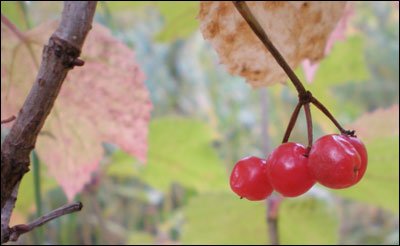
High-bush cranberries in Chugach State Park, Alaska. Thoughts about John Howerton[September 19] Jeanette Ater Corbett, now of Ellinwood, sent a note about the recently deceased John Howerton. "John was my great uncle. His first wife, Annie (the family called her Tweet), was my grandpa Frank's sister. He was also my bus driver! "I remember the day he rolled Keith Reimer off onto the floor of the bus. Keith was laying across two seat and across the aisle, sleeping. There were only three or four of us on the bus by then. I was watching John in the mirror and he got this glint in his eye and hit the brakes just hard enough to send Keith rolling off the seats and onto the floor. I laughed until I cried. "John was a good man. He was also the only person I know of with two headstones in one cemetery. I can't wait to get time to drive over to PR and see if they buried him next to Tweet or Jessie!" I mentioned a photo of Jeanette and three friends posted by my sister, Cheryl, on her FlyoverPeople site. "I liked the picture that Cheryl posted. I've got some photos from that track meet somewhere. "Great stories you've been putting on the site about your kids. Hard to believe you have a 10 year old son and I have an 11 year old granddaughter! Here's to the generations!" The Sieberts: Bob Delaplane, living in Sweden, answered the call for information about Katie Siebert, the third wife of Abraham Siebert. His mother, Gladys (Smith Delaplane), was married later to Chester Siebert, who was of that family. Bob, who seems to know everyone, has helped me out with my family's ancestry as well. Fixing up the site[September 18] PawneeRock.org always need a little sprucing up here and there. Thanks to our many and faithful readers, the errors and inconsistencies I have created are brought up and fixed. And so I'm grateful to Jolene (Dirks) Hetzke, who wrote yesterday and suggested a couple of things that need to be changed on the churches page. Thanks, Jolene. The Siebert family quest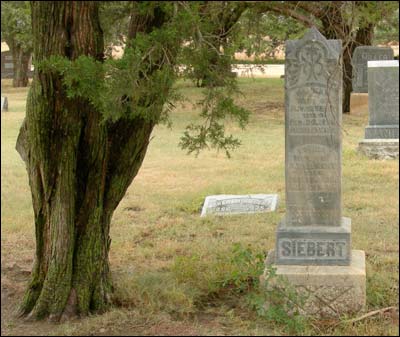
[September 18] I got an e-mail recently from Debbi Siebert, who with her husband, Bill, runs an alpaca ranch northeast of Dallas. She is putting together a family history, which led her to our hometown. "His family is Siebert & Schmidt and I am seeing lots of Unruhs, and Jantz, Janzen, Deckert, Boese mingling in the family history. Sieberts landed in the area traveling from Russia in 1874 with the Mennonite migration. "My husband Bill visited Pawnee Rock often as a child for reunions, since the grandparents and their families on both sides were from the area. His grandparents (Siebert/Schmidt) moved from Pawnee Rock area to Salina, his grandfather a cabinetmaker, a connection to the Russian/German family I am sure. Bill grew up in Salina and is an architect now in Dallas, but also loves woodworking; it's in the blood." Debbi, who originally is from Wichita, was looking for bits of information about the Sieberts. I sent her a photo of Abraham and his wives Hannah (or Hanna) and Louisa Siebert from the township cemetery. The Sieberts also are looking for information about Katie Unruh Siebert, who was the third wife of Abraham and who died in 1956. (A. V. Siebert, d. 1925 I mentioned that Grant Siebert had written a history of the Bergthal Mennonite Church. If anyone has a spare copy of the orange-covered paperback history, I know a family in Caddo Mills, Texas, who would greatly appreciate it. Julius Both, who arrived in 1871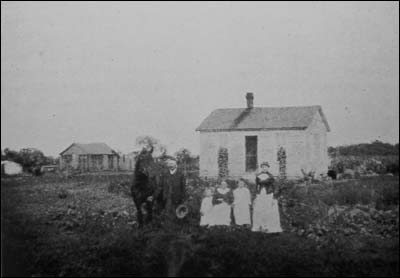
Farm home of Julius Both and Anna Both in 1886. 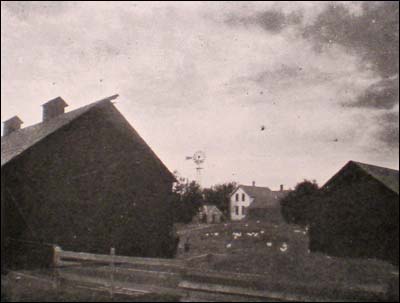
The Both farm was greatly improved by 1912. [September 17] Julius Both lived three miles north of Pawnee Rock Township, so his story isn't exactly our story. I figure, however, that it's close enough when it comes to facing the hardships of breaking the prairie while living in poverty. Both's biography, taken from the "Biographical History of Barton County, Kansas," says he claimed to be Clarence Township's first white settler. As such, he certainly picked a prime location for his home -- near the Dry Fork of Walnut Creek in the gentle and fertile hills halfway between Pawnee Rock and Albert. Using today's map, the property is located in the half-section north of NW 10th Road and NW 120th and NW 130th avenues. Here is the Both story: Julius Both"Stone Bridge Homestead," the home of Julius Both, fourteen miles west of Great Bend, takes its name from the first and only stone bridge built on Dry creek and was used as a lookout, or point of observation by Mr. Both at a time when he thought it was necessary to keep an eye on roving bands of Indians, and on the buffalo, antelope, deer, gray wolves and coyotes that infested the country in 1871. He came to the county in the spring of that year, and first worked for John Cook, Sr., and then engaged in hunting buffalo and other game for the first four or five years. In 1873 he entered his claim to a homestead, and that and later purchases make up the valuable farm of three hundred and twenty acres included in his home farm. He owns another half section in Pawnee county, and both places are well improved and in a high state of cultivation.
Julius Both claims to be the first white settler in Clarence township, and had as neighbors Judge Morton, who doctored the community, and D. M. Woodburn, who were between him and the county seat. His first acquired property was a half starved horse located from his perch in "lookout tree," and this served to transport the game which he killed, but was not sufficient to break the soil to be cultivated, and what corn that was planted was placed in holes made in the turf with a hatchet. The garden was prepared in this way and cultivated with improvised implements made from whatever would best stir or turn the soil. There was little cultivated the first five years, and Mr. Both, John Gruber and others hunted the plains and often went as far west as Dodge City. They got their supplies and mail from Russell and Ellsworth, Kansas, and were usually absent from home, leaving the care of the family and little ones to the faithful wife. Her lot was not enviable, and the pioneer mothers of Barton County deserve great praise for their fortitude and devotion to their husbands and families. Julius Both was born in the village of Linde, Germany, September 28th, 1844; served an apprenticeship as a miller, and followed the trade until coming to America in 1870. He first located at Fon Du Lac, Wisconsin, and found work in a sash factory. In the spring of 1871 he came to Barton County. He married Miss Anna Baruth shortly before sailing from his home in Germany, and they are the parents of four children: Mrs. Matilda Merten, Mrs. Mary Spies and Kate and Tina Both. The children all reside at home and assist their parents on the farm with the exception of Mrs. Merten, and with the grand children make up a happy and contented family.
This cemetery sits on the old Both homestead two miles north of 10th Street Road and a one and a half miles west of the Mennonite Church Road extended. The Larned Old Guard[September 16] The Kansas State Historical Society posted a page -- I don't know how long it has been up -- thanking the Fort Larned Old Guard for "providing onsite upkeep" of Pawnee Rock State Park. Thanks from all of us, ladies and gentlemen. The site says the work is done in partnership with the National Park Service. Perhaps that dovetails with a rumor that our state park is being folded into Fort Larned National Historic Site. If nothing else, that would explain the surveyors' stakes in the park. Jim Dye, who spoke to the surveyors, reported that they said they were hired to record what's in the park. Success, a quarter at a time
[September 16] Wall Street may have rolled over and died like a sick cow yesterday, but I struck it rich. Rich, that is, as in getting my first Kansas quarter in change since May 24, 2007. My total in the three years since the Kansas quarter was issued: 10. Somewhere, someone is hoarding Kansas quarters and flooding the market with those cheap knockoffs, the two-bison North Dakota quarters. The three other quarters in change for my dollar? Three salmon-and-grizzly bear quarters from Alaska, all of which I'll hoard. The glory of autumn to come
Where I live these days, it's now full-blown autumn. Where you live, maybe autumn is a season that is done without. But in Pawnee Rock, autumn is a spectacle of yellow cottonwoods and locust and red maples and sumac, along with reddening fields of milo. And as much as we say we hate the chilly rain, it does brighten the leaves. I went driving this past weekend and admired the leaves out of town. Cottonwoods in particular were at their best: pure yellow on a stick. It occurred to me how different it is to see a tree in the forest compared with how trees appear in Pawnee Rock -- isolated in a pasture, or in a string along a stream, or clustered around a farm or town. I couldn't figure out which view I liked more: the pretty tree in a world of color, or the lone jewel on a wide-open background. Do you know Dave Fulton? On Sunday I met Dave Fulton, who runs a lodge in Alaska. He grew up in Ellsworth (Peg Britton pointed me toward him) and went on to the Marines. He says he knows a fellow about his age (57) from Pawnee Rock, but he couldn't think of the guy's name during our conversation. Are you the guy who knows Dave Fulton? He now runs the Trail Lake Lodge in Moose Pass.
"I have a complete guess but emailed many people from Pawnee Rock," Laurie wrote. "I believe the girl in the grey t-shirt is Tricia Bright. That is just a guess." Laurie's guess seems plausible. Can anyone name the other girls or the occasion? I had come across the photo a couple of years ago in a box of school snapshots and yearbook photos lent to me by Konny in the city clerk's office when that was still in the school building. There wasn't any ID. High water: Leon Miller wrote Saturday, and I wasn't able to get his note posted before I went out of town. "As I read your article about the drenching Wichita took I'm anxiously awaiting (8:30 a.m. cdt) the onslaught of Ike. If you don't hear from me within a month you'll know the worst happened. Then again, the brunt of the storm is supposed to go east of Dallas. "On a sad note, I stayed up last night and watched a terrific game between KU and South Florida U. I'd never heard of that school but the TV announcer said they had an enrollment of 45,000. I will say it was a great battle of two outstanding quarterbacks! And how many times have you seen the quarterback going for the home run, have it come back to haunt him with an interception!? Yet, I'll still take Reesing against anyone in college today. He's today's example of Doug Flutie, Eddie LeBaren, Fran Tarkenton, and Sammy Baugh!" Up to their knees in rain[September 13] You and I and everybody we went to school with in Pawnee Rock thinks that each of us now lives in a place with extreme weather. It's the windiest, coldest, hottest, driest, snowiest, drizzliest -- or some evil combination of those conditions -- place on earth. But this week, not one of our grown-up hometowns can hold a candle to Wichita. Yesterday, Wichita collected an autumn's worth of rain -- 10.31 inches -- in a few hours. As Friday slogged into today, another 1.99 had fallen by 3 a.m. at the airport. That's 12.30 inches, which would overflow the standard Farmers Grain rain gauge twice. The Great Bend airport, by comparison, accumulated less than 2 inches. Except for the part of town where Hillside High (Wichita State University) rises, Wichita is notable for its riverbottom flatness. Now it has enough rain to fill every stream between the Chikaskia and the Smoky Hill, and you know the city doesn't have enough pumps to suck out every basement. All this rain apparently was a gift of Tropical Storm Lowell, which moved in from the southwest. Just wait until the remnants of Hurricane Ike go marching up I-35 from Texas toward Abilene. Twenty-five years ago, shortly after I moved to Wichita, I was driving up Broadway one night when a cloudburst came. There was nothing for the rain to land on but concrete. Jazz was on my radio that night, and I felt secure in my Datsun 310 cocoon. Today, however, it's hard to imagine that anyone in Wichita feels very secure. (You should be able find out more about the rain and flooding at Kansas.com, although early Saturday a lot of the McClatchy Newspaper chain sites were down.) John Howerton dies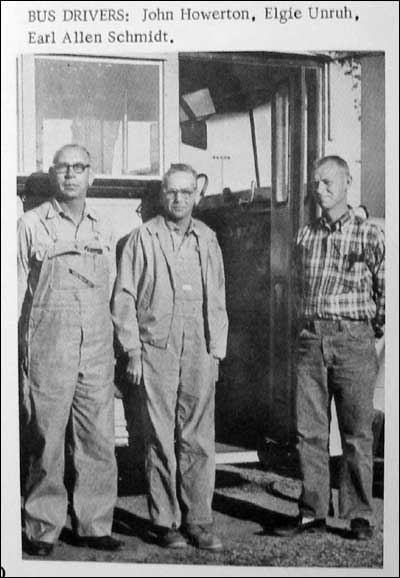
Pawnee Rock bus drivers John Howerton, Elgie Unruh, and Earl Allen Schmidt in 1971 or 1972. [September 12] John Howerton, who many Pawnee Rock students knew as a friendly bus driver, has died. He was 94 years old and had lived in the northwest corner at Houck and Flora. Mr. Howerton had also been a custom cutter; his first wife was Annie Wilson, daughter of Red Wilson, who built one of the first self-propelled combines. After her death, he married Jessie Lone in 1975, and she died in 2005. He was the son of Elijah and Mayme Howerton. Mr. Howerton is survived by sons Ralph of Hays and Jack of Lyons, stepsons Bob and Phillip Manka, both of Pawnee Rock; and stepdaughters Gloria Wondra of Newton and Kay Manka of Colorado. Another son, Wesley, died in May 2007. Mr. Howerton's funeral will be at 10 a.m. Monday in the Pawnee Rock Cemetery. (Obituary) I remember him best as a bus driver. He was the mechanic and had a special area at the front of the bus garage where he'd work. When I went with my dad to the garage to start the buses in the morning or after the evening route, sometimes he'd be there and the two men would joke around. I also liked him because he, like my dad, wore overalls. Mr. Howerton would have been in his 50s then, but he never seemed old. I think he ran the bus east of town, especially to Dundee. 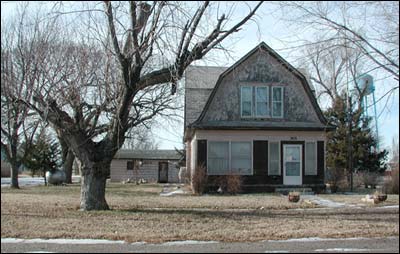 John Howerton lived in this home for decades. Music of the ages[September 12] Leon Miller, who in addition to being a retired architect also owns some property in the Dallas area, wrote about the music that impressed him after reading what I had written about my sons and music: "What a wonderful thing, having two sons who dwell on every word you tell them about their inheritance. It brings to mind how many people miss that opportunity. "I have an African-American tenant who has a recording studio and specializes in hip-hop and rap music. We were talking about variouos types of music one day and I was telling him about my favorite musicians, who included Count Basie, Duke Ellington, Lionel Hampton and Earl Garner. He had never heard of them nor had listened to their music. I was totally dumbfounded by the fact that many in the black culture fear losing their identity but fail to research their forefathers. Maybe 50 cent and P-daddy will be around for another 10 years but I don't see them with the staying power of the Big Band artists." Break on through to the other side[September 11] My guitar-playing sons are learning the music of the 1960s. The drug music, the protest music, the sappy love songs. They like rock 'n' roll, and the '60s was when rock was at its finest. It's the music that filled the sky when I was waking up to the world in Pawnee Rock. It's the soundtrack of my life, as the commercials now say. As a father, it's my responsibility to educate our sons about my music. Sam, who could spend all day studying historical time lines, likes to pick his way through the songs of the Beatles. Nik, who lives on emotion, soaks up everything I tell him about politics and the drug culture and the war, and he plays Jimi Hendrix. He's 10. As we roll down the highway, the boys insist on listening to a classic rock station, and I identify the songs and artists for them the best I can. I throw in historical context, mixing my real-life knowledge with what I learned at the time from panicky accounts on Great Bend TV and in the Hutch News. The boys are happy with that. It's education but it's not school. You and I remember our parents talking about their music -- Harry James, perhaps, or the skinny Frank Sinatra, or Nat King Cole -- and I bet you rolled your eyes more than once and found your own favorite musicians. So here's my quandary: If I tell the boys too much about The Doors, the Stones, the Supremes, and even Merle Haggard, am I inspiring them to greatness or inoculating them against rock 'n' roll fever? Am I wasting my time reliving my days on the gravel streets of Pawnee Rock? Do my boys need to play music created by their generation? I very much want the boys to understand the anti-war and civil-rights and free-love and recreational-drug movements -- and the responsible opposing viewpoints. If playing the music of 40 years ago brings that all to life, and if it helps put into perspective these repressive times, more power to my young musicians. And if the boys get a grip on all that, maybe I can begin to explain why their rock 'n' roll daddy spent three of his teenage years marching strictly to the beat in the Argonne Rebels. Flat Stanley, world traveler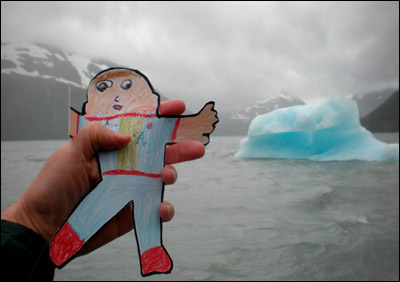
Flat Stanley wishes he had been drawn with a sweater for his trip north. [September 10] Flat Stanley came to my door late last week. Perhaps you've met him, or one of his million brothers. Flat Stanley is a character in a children's book. Stanley Lambchop was a normal kid until a bulletin board fell and flattened him to no thicker than a sheet of construction paper. His parents found they could stick him in an envelope and mail him. Curious youngsters, like my cousin Asa, aren't allowed to flatten themselves, so they draw a lookalike and send it to a distant relative, who describes where Stanley has been. The youngsters then write about it. Asa lives in Valley Center, just north of Wichita. He's a third grader, and a good student. He is certainly a good artist. The letter that came with Flat Stanley asked me to photograph Flat Stanley and to describe my locale, which as you know is somewhat different from Valley Center. Flat Stanley came to the right place. I was a pen pal writer of the highest order when I was a kid. I somewhere have a packet of letters from Uppsala, Sweden, a project of my grade-school literary adventures. Elsewhere, there are letters from Gretna, Manitoba, and Dublin, Ireland, plus one or two other towns. They're all letters traded with girls, with whom I was fascinated. What was their countryside like, I asked. What did they eat? Did they watch television (this was in the 1960s)? Was it windy? Can you send a map and pictures? Flat Stanley hadn't been born yet, and to my regret it didn't occur to me to send along to my pen pals anything like Flat Stanley that could be used as a photographic trophy. And that is why I'm a soft touch for Flat Stanley. He gets to see a bit of the world, and so does his third-grader in Valley Center, and it's so much more personal than a postcard or e-mail or a National Geographic special. In a way, it's like having Asa visit us. As I show Asa's stand-in around, I think to myself how I would explain the sights to him. My sons have been glad to take part in this adventure too. We all pretend to see our state through another child's eyes. In the next day or so, Flat Stanley will pose for a few more photos and help me write a note to Asa. Then I'll carefully fold Flat Stanley's arms and slip him into a manila envelope, affix a couple of stamps, and send him home. I'm showing one photo here, so you all can see Flat Stanley, and the rest of the shots are only for Asa's eyes. They'll be a surprise from Flat Stanley and me. Hello, Jennifer Ball-Flock[September 8] Jennifer Ball-Flock, who lives in Pawnee Rock with her husband and three children, wrote and asked to be listed on the Friends of Pawnee Rock page. Welcome, Jennifer. It's great to have you. The daughter of Dewey Jr. and Linda Ball, Jennifer was raised near the elevators on the south side of the highway. She attended the Pawnee Rock school until it was closed. She married Clifton Flock of Macksville, and they live on Pawnee Avenue in the block west of the post office. (Clifton, if I remember right, was a star athlete at Macksville High in the mid-1990s.) "This town was amazing growing up in," she writes. "Also, Pawnee Rock has a lot of history to it." Rick Clawson wants a reunion[September 8] Rick Clawson, who grew up in Pawnee Rock and now lives in the city that never sleeps -- Las Vegas -- wants to round up his classmates. He's especially looking for Tony Kassleman, Kim Myers, and David Bowman. Rick has asked to be listed on the Friends of Alaska page, so it's easy to find him. Who sends money to politicians?[September 8] Now that it's political season again and money is again the language we all speak, it's time to check in with one of my favorite websites: OpenSecrets.org. The page I linked to makes it easy to check your ZIP code to see who sent in $200 or more to a candidate, a national committee, or a special-interest group. For example, to see who with a Pawnee Rock address contributed, type in 67567, then scroll down to the bottom of the page, copy the security code, and click on Submit. Great Bend is 67530, and Larned is 67550. Hays is 67601, and Dodge City is 67801. Beyond that, run a google search for a city's name and "zip code" to find a locale. The Developing Kit[September 7] Leon Miller and I enjoyed a similar experience in photography as kids. Here's what he wrote after reading about my camera club. I think we're both glad we got our start before the digital age. "Fifty, 60 or 70 years ago taking pictures was a big deal, as photography was somewhat of a luxury. Today, with digital cameras you can take 10 photographs of the same subject, look at the immediate results and if you don't like them, discard them and start over. Nothing lost except the time it took to snap the button. "When I was 15 or 16 I built a darkroom in the basement of our house and spent many an evening developing and producing photos I had taken during the day. I got a Developing Kit for my birthday one year and put it to use making pictures for the school yearbook and other events around the community. "I used this experience my first year at Fort Hays State, when I got a part-time job at night printing school photos for a commercial photographer in Hays. I would have pursued it as a profession except I was not good enough to make a living at it. "I've always enjoyed photography as a hobby and look forward to visiting the amateur exhibit at the State Fair of Texas every year." A photo I like: No. 103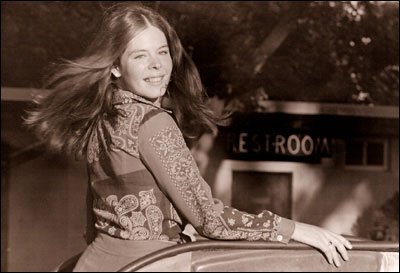
[September 6] Back in the 1970s, our camera club in Great Bend took several field trips. The one I remember most was to Brit Spaugh Park to photograph models. Most of the club members were middle-aged men, and a few of us were shy young fellows and teenagers (I was a high schooler). The one thing we all lacked was a chance to photograph with abandon someone who loved to be photographed. George Brannan, who operated a photo store and studio on Main Street, arranged for some Barton Juco students to meet us for an hour of shooting. A couple of weeks later, we'd bring our best shots to the club meeting in the annex behind the city auditorium and compare notes and techniques. I made some nice photos that evening, but this is my favorite because it brings together all the elements: a beautiful woman, flying hair, evening light, and a background sign that places the scene so well. Proud father Gary Trotnic[September 5] If you see City Councilman Gary Trotnic walking around with a big smile, ask him about his son. "My youngest son Jeffery has been a cop in Joplin, Mo., for the last 20 years. He retired Aug. 22nd. He got hired on as police chief in Onalaska, WI, Sept 2nd. We went up there to see him get sworn in." Here's the story done by a TV station in nearby La Crosse, Wisconsin. Jeffrey's photo is there, too. It sounds as if the new chief has an interesting job ahead of him. The old populist spirit[September 5] It's easy to stand on the plains and feel hammered by distant politicians and corporations, who in visible and invisible ways blow dirt and odor across the farmlands and suck the moisture out of humanity as surely as does the southwest wind. And that, over the decades, is why Kansas has been a fertile ground for alternative politics -- the third parties that arose with progressivism and populism and in righteous anger battled the distant and faceless enemies that rule commerce and culture in the lands where the population is spread thinly. Of course, the Kansas we know today has retreated from the forefront of political thought. The state, quieted by farm subsidies, has voted predictably for the status quo since casting its lot with Wendell Willkie in 1940 and especially so since Abilene's Eisenhower was elected in 1952 (the exception was LBJ over the even more conservative Goldwater in 1964), even when it might not have been in the state's financial interest to do so. To get a sense of how Bleeding Kansas once loved the nonestablishment political view, check out the maps on this American Past site. I found the Third Party Voting map fascinating. History for the kids[September 3] Last week I turned up the radio on the way home from the grocery store so our son Nik could hear a black man accept the Democratic nomination for president. Last night we recorded the GOP convention so he could absorb the speech of the first woman to accept the Republican nomination for vice president. That woman, Sarah Palin, lives just a few miles north of our place, so the moment had local interest for him; maybe he can imagine himself making that speech.
LeMay and Wallace were distant personages, and Richard Nixon and Hubert Humphrey were barely more familiar to this kid in central Kansas. But my curiosity was stirred, and I've never lost the drive to report the news about elections and politics. That's one reason I'm so looking forward to Obama-Biden vs. McCain-Palin. They are genuinely interesting candidates, and our tough-minded entrant -- Sarahcuda -- ought to make the next couple of months a lot of fun. Amid all the talk about the standard groups who will or won't be enchanted by the politics of Sarah or Barack, one 10-year-old boy is watching, listening, and learning. This election will form the basis against which he will judge all future politics. I'd like to ask the nation to keep it clean for the next two months, but that probably isn't realistic. Because of my job at the newspaper, our family can't have bumper stickers or yard signs, and I won't publicly support one candidate or another. Perhaps my objectivity will help Nik learn to see both sides and be patient with the system. On the other hand, maybe his imagination will catch fire this fall and when he grows up he'll set the world right. The Pawnee Rock network[September 3] Over the recent months, several readers of PawneeRock.org have asked for help in contacting others whose names they see in our pages. I'm glad to provide that service. Let's say you e-mail me a note or photo and I post it. A school friend sees your name and wants to write to you but doesn't see your address in the Friends of Pawnee Rock list. If your pal sends a request to me, I'll forward his or her address to you without revealing your address. You get to decide whether you want to carry on a conversation. Now, I know that not everybody's a friend of everyone else, and sometimes Person B simply has no interesting in corresponding with Person A. If you don't want to write back, you're under no obligation to. No one will know but you. One of my goals in running PawneeRock.org is bringing Pawnee Rock people together. We're spread out across the country and around the world, but we have a gathering place that not many communities do. So, first, consider listing your e-mail address on Friends of Pawnee Rock. Second, I'll do what I can to help you and your friends and acquaintances find each other. Grand Old Party in the sky[September 3] Pawnee Rock has a connection with the John McCain campaign. Leon Miller, who grew up on South Centre Street and graduated with the PRHS Class of '51, sent this note from Dallas: I want to pass on this little bit of personal joy, which means great things come to those who love their work and have patience to see it through. My oldest son, Kyle, lives in Nashville. He went their in 1984 to get an education at Belmont College, and studied sound engineering in a school that aligned itself with the Nashville music industry. After 2 1/2 years he decided that school wasn't for him and he formed/joined a rock band, wanting to make a name for himself on stage (that was about the same time that Garth Brooks came to Nashville). After a number of years of frustration (the entertainment world can be very cruel) he realized that to eat he had more of a chance of success by using the education he got at Belmont and got employment running sound monitors for country/western artists. Over the years he has become quite proficient at it, working for the likes of Webb Wilder, Suzy Bogguss, Keith Urban, Sammy Kershaw, Blake Shelton, Gary Allan, and now, John Rich (Big and Rich). This past Sunday night he called me and told me about his weekend experience. We'll preface this by letting you know John Rich is a BIG promoter of Senator John McCain, and has written a campaign song titled, "Raising McCain!" You may have heard it. (YouTube video) Anyway, John Rich and his group (including Kyle) were performing Friday at some Indian reservation in Oklahoma. After that show was over Kyle said they were picked up by John McCain's personal jet, a Gulfstream IV, and flown to Pittsburgh, PA, where they performed at a rally in Washington County, PA, on Saturday. The next day they all boarded McCain's, and the Republican Party's, main 737, for a trip to St. Louis, MO, to perform at another rally Sunday afternoon. Kyle said they were seated in the middle of the plane and he was chatting with a girl across the aisle when she said, "Let me go get my Dad and let you meet him." Kyle had no idea who she was and who she was talking about. She disappeared through the curtain separating the private quarters of the McCains, and returned shortly with the Senator and Cindy McCain. Kyle shook both their hands as well as meeting Governor Palin and her family. It was the thrill of a lifetime! Kyle told me he had some very unique birthday gifts for me (my 75th is in a couple of weeks), i.e. gimme cap, campaign badge, paperweight, ballpoint pen, etc., but as the people on the plane told him, these are special in that the only those who travel on the soon to be president's plane are privy to the gifts. Oh? How can I make such a prediction? I met Keith Urban here in Dallas at what you may remember as the Starplex Stage at Fair Park, and told him then that he was going to be the No. 1 entertainer someday. The prediction turned out to be right! The storm goes by[September 2] We all know the sense of relief we felt when a big thunderstorm, heralded on the Great Bend and Larned radio stations, passed us by in Pawnee Rock and damaged some other township's wheat instead. We know what it's like to drive west on the highway and watch a storm rise up in front of us. So you can imagine what it's like to live in southern Louisiana and watch storms so big they have names draw a bead on your town. That Mississippi-Louisiana-Texas coastal band is going to get a lot of rain out of the remnants of Hurricane Gustav. I saw an estimate that two feet might fall, and it's going to spread northwest into the Dallas area. Over the millennia, nature has adapted that landscape to handle runoff. Can you imagine that much water being dumped on our little piece of the Great American Desert? On the other hand, Pawnee Rockers can handle the wind that so gleefully ruffles the hair of frightened TV-network correspondents. Good luck to all our friends and fellow Americans to the south. "So say you one, so say you all"[September 1] I grew up idolizing Encyclopedia Brown and the Happy Hollisters, a boy and a family dedicated to fighting crime with their wits. I've written a few police stories for various newspapers, and I've edited hundreds of them. But I knew very little about how real police investigations and trials work. So it was with a great deal of interest that I answered a federal summons to show up for jury duty (the courts call it jury service) two weeks ago this morning. I promised earlier to let you know how it went. Our group of 50 or so was called to try United States vs. Imad Salim Hereimi in a mail-fraud case. After answering a series of questions, I was selected for the jury. More accurately, I was not deselected, as the actual procedure allows the prosecution and defense lawyers to trim away any potential jurors they think would put their side at a disadvantage. When the dust settled, I was juror No. 7. We were not, the judge said, to discuss the case with strangers or friends or family or other jurors. We were not to acknowledge the prosecutor or defense lawyer if we met them on the stairway. We were not to watch local news or read the newspaper, which meant that I could not work the extended shift -- 9 to 5 at the courthouse and then 5 to 8 at the newspaper -- that my bosses wanted. Until the trial was over, I stayed out of the office and steered clear of everything in the morning paper but the comics and sports. As much as I wanted to know about the procedures of a trial, I was just as curious about being a member of a jury. I considered it a big test of personal ethics and my ability to stand up to a roomful of people who might disagree with me; would I be smart enough and strong enough? The trial itself was dry. There were repetitive exhibits: bank statements, bank deposits, invoices, photographs of offices, and photographs of a confiscated pickup. One witness got angered by questions on cross examination, and the defendant wore a smile only on the witness stand. The lawyers did not act like TV lawyers. There were no showdowns. Mr. Hereimi, a donut maker who wanted a second career with less physical stress, was accused of setting up a printing-broker company with his brother and another man, a graphic designer for the state who had signed an ethics pledge not to have an undisclosed outside interest in any printing businesses. In the scheme, the state worker had real printing companies do the actual printing of genuine state projects, which he paid for with a credit card owned by his co-business owner and then jacked up the bill he presented to the state. Inflating the bill wasn't a crime. The actual charges dealt with whether the defendant used the mail (which made it a federal case) and knew that the state worker was violating the ethics law. The state worker had a familiar name. Shortly after the September 11 attacks, the worker, then a popular Middle Eastern immigrant who owned a strip-mall print shop, found his shop vandalized with anti-Arab slogans. He was later suspected of causing the vandalism himself, although those allegations didn't stick. He was, however, convicted of not mentioning a previous bankruptcy on a loan application. One of the conditions of his probation was that he not get any new loans or credit cards without notifying his probation officer, which he did not do. His repeated use of the credit card, violating a state payment procedure, prompted a printer to call the state troopers, who began the investigation that led to Mr. Hereimi's indictment. The judge had warned us to avoid creating our opinions until we had heard all the evidence. We heard from about a dozen witnesses, including printers, an FBI agent, a probation officer, a state trooper sergeant who specializes in white-collar crime, the defendant, a police officer who frequented the donut shop, and the graphic designer's ex-wife and estranged daughter. The graphic designer himself fled several months ago and is thought to be living in Syria. The defense strategy was based on the notion that donut maker had been lied to by his friend. We heard time and again that the graphic designer built sympathy with Mr. Hereimi by claiming to have been discriminated against because of his heritage. The courtroom part of the trial lasted five days, and then we jurors were closed up in the jury room, a functional rectangle of about 20 by 10 feet. There were two restrooms, a coffeemaker, and a small refrigerator for soft drinks and juice supplied by the court. The court had lunch delivered, and we could take a stroll outside the building as long as we walked together in the company of a bailiff. Juries are by reputation stressful. Only one juror broke into tears during our deliberations, and that was because the defendant had been painted as the victim of a scam and the juror understood too personally how a scammer could tear apart a family. But that passed, and we immersed ourselves in the judge's instructions and the looseleaf books of evidence. We were eight women and four men; six from the city and six from the suburbs and distant towns; and ten whites, a black, and a Honduran immigrant. We were a retired structural engineer, an accountant, a furniture saleswoman/bartender, a college staff member who works with the disabled, the homemaker wife of a mining executive, a retired postal worker, a small-equipment repairman, a college instructor, a military commissary clerk, a hardware store owner, one whose occupation I don't know, and a newspaper wire editor. We were not alike in obvious ways, yet individually we had enough in common that we could trust one another. Our separate expertises each played a part, whether it was common sense or business-related, in solving the mystery before us. And we were dedicated to our job. Even after we determined the general likelihood that the defendant was guilty, we pored over the evidence in each of the 20 counts, one by one, making the government prove guilt in a process that lasted until Friday morning. We determined that by his actions and his testimony, Mr. Hereimi had revealed that he knew from the start that his friend was violating the ethics law and that he had used the mail as part of the scheme. We found Mr. Hereimi guilty on all the counts. Forty-five minutes after we notified the judge that we had reached a decision, the parties were collected and we were summoned back to the courtroom. The foreperson (the college staff worker) read the verdict, and the judge asked each of us whether we agreed. "So say you one, so say you all," intoned the court clerk, and the judge accepted the verdict. The judge thanked us and dismissed us, and the courtroom's inhabitants silently watched us parade to the jury room, from which we were escorted through the back hallway to the jury clerk's office. We received our certificates of service and the clerk's thanks and were sent out the door. Mr. Hereimi will be sentenced later. The trial was not like on court on TV, nor was it like the easily solved morality plays of children's books. The machinery of a federal court moves deliberately, and it seems to me that in our case justice -- as defined by the court's instructions and the evidence -- found its way to the surface. |
Sell itAdvertise here to an audience that's already interested in Pawnee Rock: Or tell someone happy birthday. Advertise on PawneeRock.org. |
|
|
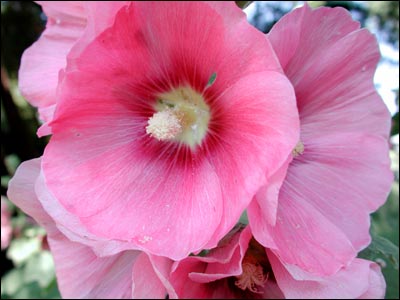
 Clint Bowyer, our racer: It has been a year since
Clint Bowyer, our racer: It has been a year since 
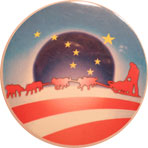

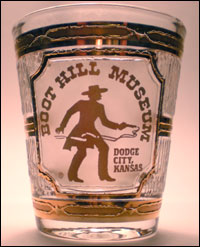 Lightning straight from God would kill us if we were caught gambling -- or even talking about gambling -- in front of the preacher or the churchwomen, although I suspect that most members of the Lions Club and American Legion wouldn't have minded so much.
Lightning straight from God would kill us if we were caught gambling -- or even talking about gambling -- in front of the preacher or the churchwomen, although I suspect that most members of the Lions Club and American Legion wouldn't have minded so much.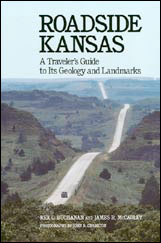
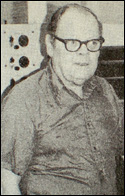 "I read the obit for Mrs. H. Daniels. Her grandson Vernon Chestnut Daniels and his wife, Leona Grover Daniels, and their children lived next door to us when we first moved to Larned. He was known as Pete and worked in the printing room of the Tiller for many years. You probably knew him."
"I read the obit for Mrs. H. Daniels. Her grandson Vernon Chestnut Daniels and his wife, Leona Grover Daniels, and their children lived next door to us when we first moved to Larned. He was known as Pete and worked in the printing room of the Tiller for many years. You probably knew him."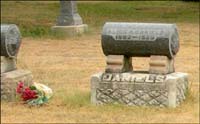 On another level, I am personally grateful to Dana for sending this obituary. Without it, I doubt that I would ever learned about the Daniels grave markers, the granite cylinders that are two of a kind in our township cemetery. They've always been among my favorites.
On another level, I am personally grateful to Dana for sending this obituary. Without it, I doubt that I would ever learned about the Daniels grave markers, the granite cylinders that are two of a kind in our township cemetery. They've always been among my favorites.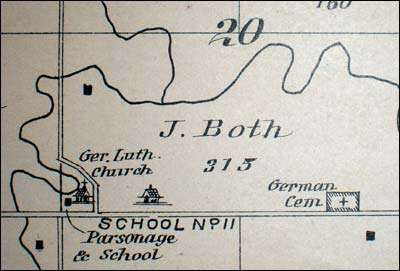
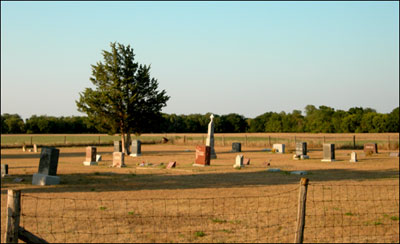
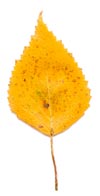 [September 15] It's the time of the state fair and football, and it's time for Kansans to start remembering which cabinet the sweaters were stuffed into last March. Soon the trees will be turning, and yellow and maybe red again will be on the newspapers' front pages (it always suprises newspapers when autumn arrives) as well as falling on your lawn.
[September 15] It's the time of the state fair and football, and it's time for Kansans to start remembering which cabinet the sweaters were stuffed into last March. Soon the trees will be turning, and yellow and maybe red again will be on the newspapers' front pages (it always suprises newspapers when autumn arrives) as well as falling on your lawn.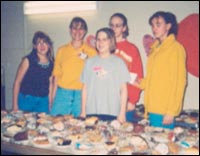 The bake sale girls: Laurie Chapman, our Florida correspondent, has an idea about one of the bake sale girls featured this weekend on the homepage.
The bake sale girls: Laurie Chapman, our Florida correspondent, has an idea about one of the bake sale girls featured this weekend on the homepage.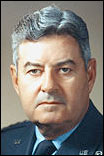 I thought back to my first political convention, which I, an 11-year-old, watched in the darkened basement of our house next to the old fire station. It was October 1968, and the hawkish former Gen. Curtis LeMay was selected by George Wallace's American Independent Party as its vice presidential candidate. I ran yelling upstairs to tell my parents, who weren't as excited by the news as I was. (Mom wouldn't have been caught dead voting for Wallace, and my dad's interest in any politics was very low.)
I thought back to my first political convention, which I, an 11-year-old, watched in the darkened basement of our house next to the old fire station. It was October 1968, and the hawkish former Gen. Curtis LeMay was selected by George Wallace's American Independent Party as its vice presidential candidate. I ran yelling upstairs to tell my parents, who weren't as excited by the news as I was. (Mom wouldn't have been caught dead voting for Wallace, and my dad's interest in any politics was very low.)